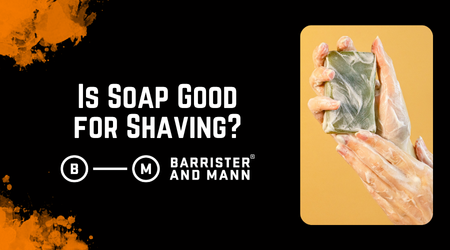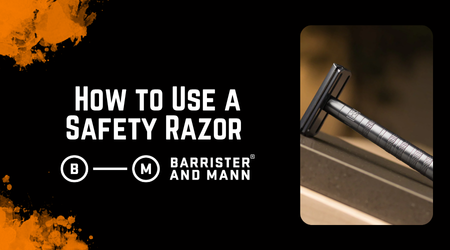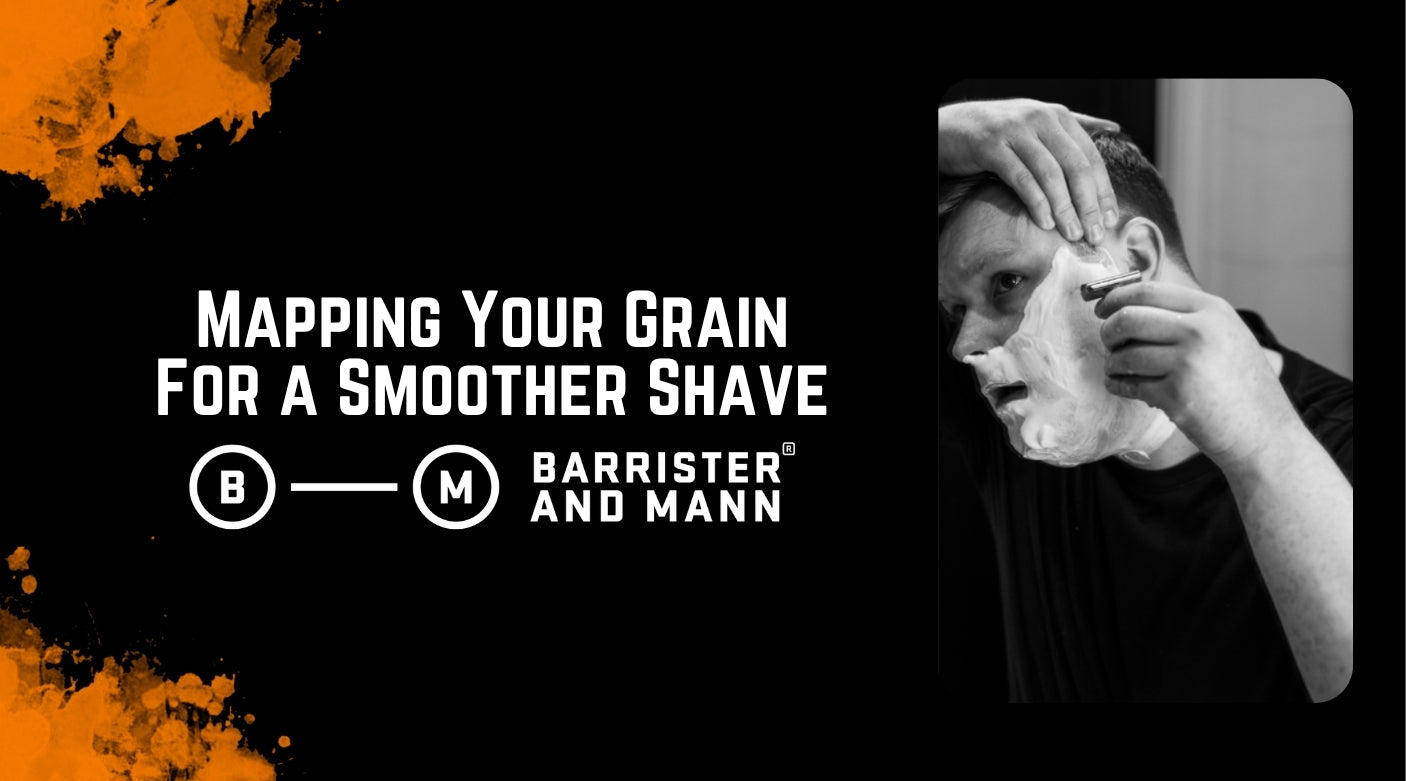Shaving soap is a specialized soap designed to cushion the blade, soften the hair, and protect the skin. It builds a dense, slick lather that hydrates while you shave. A regular bar of soap can work in an emergency, but it is no substitute for the real thing.
-
Shaving soap comes in several formats: Hard pucks last longest but require more work. Poured soaps, like most artisanal soaps, offer rich lather with less effort.
-
Shaving soap is built for performance: With a high-fat base, moisturizing agents, and low alkalinity, it cushions the blade and retains hydration, giving you a smoother, safer shave whether you're shaving your face, legs, or anything in between.
-
Regular soap is not designed for shaving: It cleans the skin but offers little glide or protection. That lack of slickness increases the risk of tugging, nicks, and irritation during the shave—unless it's pure olive oil castile soap, which, while low on cushion, is extremely slippery and shaves surprisingly well.
-
You can use regular soap in a pinch: But expect drag, drying, and subpar glide. It will work if you're desperate. Oil would still be the better fallback.
-
Some shaving soaps are easier to work with than others: Softer soaps tolerate hard water, build lather faster, and require less technique.
Want the whole picture before you lather up? Here it is.
What’s the Difference Between Regular Soap and Shaving Soap?
Regular soap is made to clean — that’s its main purpose. It strips away dirt, oil, grime, and anything else you’ve picked up since your last rinse. It does that job well. But shaving isn’t quite the same as cleaning.
Shaving is a form of controlled abrasion. You are dragging a sharp piece of metal across your skin, hoping to avoid irritation or injury. To do that safely, you need protection, a layer of cushioning, and a smooth glide. Regular soap simply is not designed to provide those things.
Shaving soap, by contrast, is made with a single purpose in mind: to reduce friction, hydrate the hair, and allow the blade to move freely without leaving your skin irritated or damaged.
-
Regular Soap: Designed to break down oils and remove buildup
-
Shaving Soap: Designed to retain moisture and protect during shaving
-
Different Goals, Different Outcomes: What works in the shower fails under a razor
So yes, if all you want is clean skin, go with standard soap. But if you are shaving and want your skin to stay calm and intact, you are going to need the right tool for the job.
The Chemistry Behind the Lather
Here’s where the real divide opens up. Regular soap uses surfactants that lift oil off your skin. They foam quickly, rinse fast, and they dry you out in the process.
Shaving soap is built differently. You get high-fat formulations with humectants like glycerin, plus added skin soothers like shea butter, avocado oil, and slippery elm. These ingredients create a dense, elastic lather that clings to the skin and supports the blade.
You are not looking for bubbles; you are looking for glide, for stability, and for a product that stays in place during your shave rather than disappearing before you make your second pass.
That is the job of shaving soap. And if your current soap cannot handle that, it is time to switch.
Can You Use Regular Soap for Shaving?
Technically, yes. You can use regular soap to shave. If you are caught without anything else and a bar of hand soap is the only thing standing between you and a razor, it will do something. Just don’t expect it to do a good job.
What you end up with is drag. The lather breaks down quickly, and any slickness fades halfway through the stroke. As a result, you push harder, the blade begins to skip, and irritation starts to build. After the shave, your skin feels tight and raw. You might get the job done, but your skin bears the cost.
We have seen it before.
-
Sticky lather: Does not hold structure
-
Drying effect: Strips natural oils your skin actually needs
-
Increased friction: More tugging, more razor burn
-
No cushion: Leads to micro-cuts, especially around angles and contours
A basic shave oil would outperform body soap in every one of these categories. Even if you are using a cartridge razor, it is worth finding something built for the task.
Body Soap vs. Shaving Soap Performance Test
We have done the side-by-sides. Body soap barely builds a lather and what does build fizzles out before the first pass is finished. Shaving soap builds lather that lasts, holds shape, and gives the razor something to glide through.
The difference becomes especially clear in areas like the jawline or just beneath the nose, where precision matters and the blade needs all the help it can get.
What Forms Does Shaving Soap Come In?
Shaving soap is not a one-size-fits-all product, as the format affects how it lathers, how long it lasts, and how easy it is to work with. Some people prioritize speed, while others enjoy the ritual. Ultimately, the right choice depends on what you value most in the experience.
Hard Pucks: Durable and Travel-Ready
Hard pucks are the traditional format. They are dense, dry, and take effort to load onto a brush. But once you figure them out, they last forever and can survive just about any travel situation.
You will need more time and a bit of technique. They do not give up lather easily. But they are compact, leak-proof, and friendly to your TSA screening.
-
Pros: Long-lasting, solid format, clean for travel
-
Cons: Slower to lather, less forgiving in hard water
-
Best for: Frequent travelers, traditionalists, those who enjoy the process
Milled Soaps: Long-Lasting but Less Common in Artisan Circles
Milled soaps go through a mechanical process that squeezes out water and makes them even harder than a standard puck. They are shelf-stable and often fragrance-light. You will mostly see these in older European brands.
-
Pros: Excellent shelf life, good for high-volume shaving
-
Cons: Harder to break in
-
Best for: Minimalists, bulk buyers, collectors of vintage gear
Poured Tubs: Performance First
Poured shaving soaps are softer, denser, and built for performance. This is the format most artisan producers use, including us. It allows for richer base composition and greater control over scent and texture.
They lather faster than pucks, tolerate hard water better, and deliver more hydration. They are not as TSA-friendly due to the semi-solid consistency. But at home, they are unbeatable.
-
Pros: Faster lather, more cushion, fragrance-forward
-
Cons: Bulkier for travel
-
Best for: Daily shavers, beginners, anyone who wants the best lather with the least effort
If you care about skin feel, fragrance experience, and hydration during the shave, this is the one. Poured soaps deliver.
Which Shaving Soap Is Easiest to Use?
If you are just getting into traditional shaving or want something that works without fuss, some formats are clearly more beginner-friendly than others. You do not need to master the brush swirl or chase the perfect water ratio right out of the gate. Start with something that works even when your technique doesn’t.
For Beginners: Use a Poured Soap
If you are just getting started, poured soap is the way to go. It is softer than a milled puck, easier to lather, and built to perform even when your technique is not perfect.
We make ours this way on purpose. A good shave should not require a chemistry degree. You should be able to load your brush, swirl a few times, and get a dense, creamy lather that cushions the blade and protects your skin.
-
Poured consistency: Easier to load and control
-
Forgiving in hard water: Often formulated for hard water, unlike pucks
-
Beginner-friendly: Built for results, a few errors won’t ruin the shave
Use a Brush—Even with a Cartridge Razor
There is a persistent myth that a brush and soap are only for safety razors. That is wrong. The razor you use does not change the benefit of better lather.
A proper brush builds cushion and structure. It lifts the hair and exfoliates gently, allowing you to achieve closer shaves with fewer ingrown hairs, leaving your skin feeling cared for rather than irritated or punished.
If you use a Mach 3 or a Quattro, that is fine. Just upgrade your prep. You will notice the difference immediately.
Brush Types Matter
Whichever soap you use, a brush is essential. It builds real lather. It lifts the hair. It helps the soap do its job. Without one, you are just smearing foam around and calling it good enough.
The brush does not need to be expensive. But it does need to work. Pick something that fits your routine.
-
Synthetic: Easiest to use, no break-in, dries fast, and works with every soap base we make
-
Boar: Budget-friendly and underrated, needs a few weeks to soften, but delivers great backbone
-
Badger: Traditional, luxurious, and holds water well, but costs a lot more. Not a requirement
We design our soaps to work with all three. You do not need to overthink it. Just get one that feels right in your hand and makes the shave easier.
What Sets Barrister and Mann Shaving Soap Apart?
Not all shaving soaps are created equal; while some exist merely to check a box, ours is designed to solve a real problem — how to achieve the best possible shave without compromising your skin, scent, or overall satisfaction.
We did not start this company to sell rebranded foam. We built it to make shaving better, and that starts with how we think about the soap itself.
Performance at the Molecular Level
In the early 2010s, artisan soapmakers began refining their formulas with greater intensity, and we found ourselves right in the middle of a period of wet shaving history known as “The Base Wars”, testing base after base and formula after formula as we worked to solve the problems that other products simply ignored.
We added humectants to combat dry air, included chelators that could tolerate hard water, and incorporated botanicals that soothed the skin on contact; we tore the formula down and rebuilt it multiple times until we finally achieved perfection.
That is why our soaps hold their structure and cling to the skin instead of simply dripping down the drain, creating a lather that looks like Greek yogurt and feels as smooth and luxurious as velvet.
-
Hydration-focused base design
-
Stable in hard water
-
Supports every pass of the razor without breaking down
Fragrance as High Art
Most brands treat scent as an afterthought, but not Barrister and Mann.
For us, fragrance is just as important as skincare. Shaving soap becomes a vehicle for original perfumery, a way to tell stories; some evoke nostalgia, others feel strange, and some are deliberately composed to challenge and rattle expectations.
Our inspirations come from folklore, forgotten history, dusty libraries, burned incense, holiday dinners, leather jackets, and backroom jazz clubs. We don’t simply follow trends; instead, we follow curiosity and let it guide everything we create.
No Dupes, No Shortcuts
We don’t copy what’s already found on every department store shelf, but sometimes history offers us something truly worth preserving.
Fragrance is full of ghosts. Beautiful, strange compositions that vanished when a formula changed beyond recognition, or a house shuttered its doors. When that happens, and only then, we step in. Not to dupe, but to preserve.
Recreating these lost scents is a form of tribute. A way to bring artistry back into the world when the original has been erased. We rebuild from scratch using the best modern materials available. We stay true to the spirit, not just the structure.
-
No trend-chasing: Our scents are driven by narrative, not market data
-
Preservation over duplication: We recreate only when something vital has been lost
-
Built from scratch: Every fragrance is our own interpretation, never a copy-paste formula
If a scent still exists, we leave it alone. But if the world forgets one that should not be forgotten, we will step in to save it.
The Right Soap for the Job
Shaving is not just about removing the hair; it is also about how your skin feels afterward, about the smooth glide of the blade, the softness of the lather, and whether the mirror reflects irritation or relief when you are finished.
Hand and body soap was never designed to handle that; it cleans, of course, but it dries out quickly, collapses under pressure, and ultimately turns shaving into a chore. While it will work if you have no other option, it won't give you a shave you will want to repeat.
Shaving soap does much more; it is specifically designed to create a stable, hydrating lather that cushions the skin and softens the hair, supporting every pass of the blade and leaving your skin feeling calmer rather than stripped.
If you care about comfort, if you want the blade to glide smoothly instead of dragging, and if you believe your skin deserves more than just the bare minimum, then you are ready for the right soap. Here are some suggestions to get you started.
-
Seville – Our best-selling shaving soap, affectionately dubbed “God’s barbershop,” delivers elite performance and a scent you’ll actually look forward to.
-
Waves – Another of our best-sellers, Waves is crisp, clean, and endlessly wearable. A fresh blend of sea notes, lavender, geranium, and bergamot, it feels like salt air on warm skin and pairs effortlessly with whatever the day throws at you.
-
Spice – Classic Americana in a tub. Carnation, nutmeg, vanilla, and tonka bean create a warm, nostalgic lather that’s as timeless as it is comforting. Suave, familiar, and effortlessly cool—for anyone who knows the old ways still work best.


